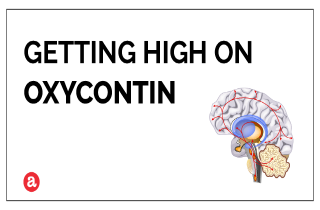Yes. OxyContin can get you high.
OxyContin is an opiate, and in addition to its therapeutic effects, it can act on the pleasure centers of the brain. However, OxyContin is also very addictive, so it’s only available with a doctor’s prescription and is illegal to use otherwise. And OxyContin shows up on drug tests. Here, we explore the chemistry and use of OxyContin as well as the dangers of OxyContin addiction (you can die from OxyContin overdose). And we welcome your questions about OxyContin at the end.
OxyContin chemistry and use
The active ingredient of OxyContin is oxycodone, an opiate painkiller. Oxycodone works by changing the way the brain and nervous system respond to pain, and is often used to help manage chronic pain. While oxycodone is often mixed with other non-narcotic painkillers (ibuprofen, acetaminophen, aspirin), in OxyContin it’s taken alone. This minimizes the risk of toxicity found in some of these combination drugs. OxyContin how long in system? Up to 3 days in urine, and potentially longer for chronic users.
OxyContin and euphoric effect
One side effect of OxyContin is that the oxycodone found in OxyContin can cause feelings of euphoria, even hallucinations. Opioids like OxyContin act by attaching to specific proteins called opioid receptors, which are found in the brain, spinal cord, and gastrointestinal tract. When these compounds attach to certain opioid receptors in the brain and spinal cord, they can affect regions of the brain that mediate pleasure, resulting in a deep sense of well-being, or feeling “high”. Euphoria is more likely to occur when the medication is taken in doses larger than typically prescribed for therapeutic purposes, or when it’s not being used for a legitimate medical reason.
Getting high on OxyContin
OxyContin tablets come in controlled-release formulas to prevent abuse. Newer formulations of OxyContin are designed to prevent tampering, making it harder to abuse or accidentally overdose. But many people will chew the tablets to bypass this feature. Others will crush the pills and snort the powder, or mix it with liquid and inject it. These ways of taking Oxycontin are all dangerous because of the large dose involved. Intravenous drug use carries with it a risk of contracting blood-borne viruses, including HIV and hepatitis B and C.
OxyContin and central nervous system effects
OxyContin is a central nervous system depressant. It can cause:
- drowsiness
- headache
- lightheadedness
- nausea
- mood changes
- weakness
Mixing OxyContin with other substances
OxyContin can be very dangerous when mixed with other substances. Mixing OxyContin is a particular problem when combined with other central nervous system depressants. Alcohol, sedatives, and tranquilizers can increase the risk or adverse effects, coma, overdose or even death.
Risks of OxyContin abuse
Abusing OxyContin is very risky! Users can develop a physical tolerance and need to take higher doses over time to achieve the desired effects. They may even develop an addiction and drug-seeking behavior. This can cause serious and painful withdrawal symptoms, including a racing heartbeat and breathing. However, the greatest risk of abusing OxyContin is overdose. If not treated promptly, OxyContin overdose can lead to death. The signs and symptoms of an overdose can include:
- cold/clammy skin, which may be blue around the fingernails, lips, or face
- difficulty breathing, or slowed/stopped breathing
- dizziness or fainting, excessive sleepiness
- increase or decrease in pupil size
- limp/weak muscles
- loss of consciousness, fainting, or coma
Am I addicted to OxyContin?
Repeated abuse of opioids like Oxycontin can lead to addiction. Addiction is characterized by compulsive OxyContin seeking and abuse despite the known harmful consequences. So ask yourself the following questions: Do you take OxyContin for reasons other than pain management? Do you need to take OxyContin on a regular basis to avoid feeling sick or anxious? Do you crave the OxyContin? If so, you may be addicted to Oxycontin.
Help for OxyContin abuse
A doctor will be able to help you gradually reduce your dosage and quit taking OxyContin. They can also refer you to therapists and support groups, vital resources in the fight against addiction. But your greatest resource when quitting OxyContin is, of course, yourself. You can avoid people, places, and situations that you find make you more likely to abuse OxyContin. You can ask friends and family members to help you and hold you accountable for your OxyContin use. Taking responsibility for your OxyContin addiction in this way is a powerful tool that can make the difference in quitting for good.
Getting high on OxyContin questions
Do you still have questions about getting high on OxyContin? We will try to help you as best we can. Please leave us your questions and comments below and we will do our best to respond to you with a personal and prompt reply.









Related Posts